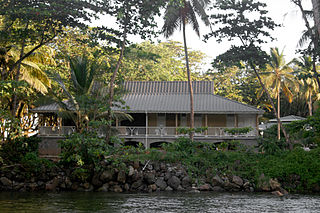
The Gulf of St. Lawrence is the outlet of the North American Great Lakes via the St. Lawrence River into the Atlantic Ocean. The gulf is a semi-enclosed sea, covering an area of about 226,000 square kilometres (87,000 sq mi) and containing about 34,500 cubic kilometres (8,300 cu mi) of water, at an average depth of 152 metres (500 ft).

The Arctic Archipelago, also known as the Canadian Arctic Archipelago, is an archipelago lying to the north of the Canadian continental mainland, excluding Greenland and Iceland.

The Mid-Atlantic Ridge is a mid-ocean ridge located along the floor of the Atlantic Ocean, and part of the longest mountain range in the world. In the North Atlantic, the ridge separates the North American from the Eurasian Plate and the African Plate, north and south of the Azores Triple Junction. In the South Atlantic, it separates the African and South American plates. The ridge extends from a junction with the Gakkel Ridge northeast of Greenland southward to the Bouvet Triple Junction in the South Atlantic. Although the Mid-Atlantic Ridge is mostly an underwater feature, portions of it have enough elevation to extend above sea level, for example in Iceland. The ridge has an average spreading rate of about 2.5 centimetres (1 in) per year.

Charlotte is the largest parish of Saint Vincent and the Grenadines, situated on the eastern coast of the island of Saint Vincent. With an area of 149 km², its size is comparable to that of the British Virgin Islands. It’s the country‘s largest parish by area and the second most populous one. The parish has the longest coastline of all the parishes and is also larger than the three smallest parishes combined. The parish possesses a very rough and rugged topography with very little flat land occurring towards the coast. as a result of these features, parts of the north of the parish cannot be accessed by a main road. Up until the building of a bridge over the Rabacca Dry River access to the north side of the river was not possible when rain caused the river to swell and make the path impassable.

Grenadines is an administrative parish of Saint Vincent and the Grenadines, comprising the islands of the Grenadines other than those belonging to Grenada. The capital is Port Elizabeth.
The Stikine Ranges are a group of mountain ranges and mountainous plateaus in northwestern British Columbia, Canada. They are the northernmost subdivision of the Cassiar Mountains and among the least explored and most undeveloped parts of the province.

Rosalie is a village in Dominica. It is located in Saint David Parish at the northern end of Rosalie Bay, on the central east coast of the island, close to the mouth of the Rosalie River.

Matadeón de los Oteros is a municipality located in the province of León, Castile and León, Spain. According to the 2004 census (INE), the municipality has a population of 283 inhabitants.
The Maguse River is located in the Kivalliq Region of northern Canada's territory of Nunavut. It originates at Maguse Lake and flows 56 km (35 mi) eastward to northwestern Hudson Bay. At one time, there was a trading post at the mouth of the river.
The River Canari is a river on the Caribbean island of Dominica. The adjacent rock formation, which is a persistent 80 degrees Celsius for much of the year, has been discussed as a potential site for an enhanced geothermal system for electricity generation.
The Check Hall River is a river on the Caribbean island of Dominica.
Clarke's River is a river on the Caribbean island of Dominica.
The Maréchal River is a river on the Caribbean island of Dominica.
The Mamelabou River is a river in Dominica.
The Point Mulâtre River is a river in Dominica.
The Taberi River is a river on the Caribbean island of Dominica.
The Trois Pitons River is a river on the Caribbean island of Dominica.
The River Sarisari is a river on the Caribbean island of Dominica.